
Fractures Page Menu: 1 2 3 4 5 6 7 8 9 10 11 12 Next>>
Fracture Treatment During the Golden Age of Piracy, Page 10
Preserving Tone: Medicines
We have already seen medicines in use both for treating bandages applied to the fracture and treating the wounds that accompany compound fractures. However, medicine had some other roles during fracture healing.
Oral Medicines
Very few oral medications are prescribed in curing fractures. The most vigorously promoted is by John Woodall. He strongly supports Lapis Zabulousus or Lepis Abulosus which is a German patent medicine. Woodall explains that it is called Beine bioucite in German, explaining that "in our language [beine bioucite] is a broken bone, being in substance like chalke and in forme like a bone...
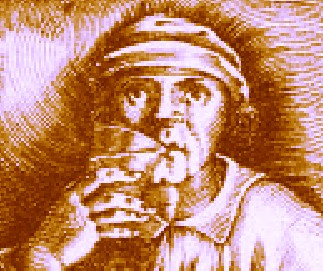
Artist: Jan van der Straet - Oral Medication (1600)
This medicine I know to excell many others in healing fractures both outwardly applied in cataplasmes"1.
Orally, Woodall recommends that it be "inwardly taken daily the quantity of {1 ounce} in fine powder in wine, beere, or water, the patient fasting for two houres after the taking thereof. In great fractures, the Germane Surgions, prescribe this aforesaid medicine daily to be taken for twenty foure dayes, if they see cause so long to use it"2. He likes it so much, he recommends it again, suggesting that a dram of it be put in the patient's beer or wine "for tenne or fourteene daies if you have it"3.
One other surgeon recommends an oral medication. During a fractured thigh case study, fellow sea surgeon John Atkins prescribes "the following composing Draught. Rx. Aq. Theriac. [Treacle in water] Syr. de Mecon. [syrup of poppies - opium] {half ounce} Laud. Liq. [liquid laudanum] {16 grains} Aq. Hord. [barley water] {2 ounces} F. Haust. [make into a draught]."3 While Woodall's magical potion was recommended to cure the fracture, Atkins' seems to be focused primarily on relieving pain given all the opiates it contains.
1,2 John Woodall, the surgions mate, p. 163; 3 Woodall,p. 166; 3 John Atkins, The Navy Surgeon, p. 59
Plasters
"Then [after Restoring the Bone] extend the Part again very Moderately and Even, and apply your Plaister round the whole broken Part, not one side of the Plaister over the other, but let it want about and Inch and half of coming together." (Matthias Gottfried Purmann, Chirurgia Curiosa, p. 213)
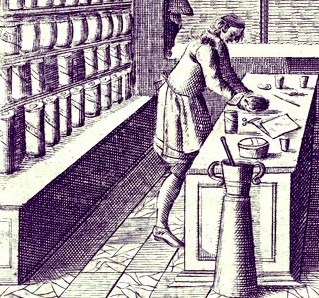
An Apothecary Making Medicines from Georgica
Curiosa Aucta
by Wolfgang Helmhard Hohberg
(1695)
Before applying a plaster, some period authors advise putting medicated bandages on the part, reminiscent of John Moyle's bandage coated with Defensiv. Magnum1 discussed previously. Richard Wiseman suggests using folded, medicated linen cloths on the fractured limb, although he does not specify the medicine. He explains that these pieces of cloth are "spread lightly with a little Cerote made of axungia and Wax [wax combined with hog's lard], to make them adhere where I placed them."2
Plasters were used to strengthen the healing bone fracture and to "prevent the Influx [of humours] from above."3
Some period
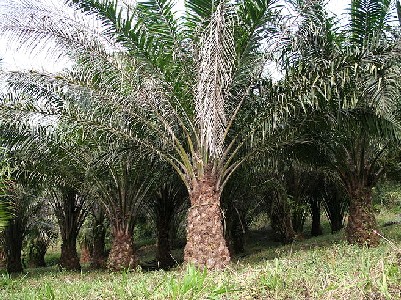
Photo: Marco Schmidt - Oil Palms
authors specify the types of plasters to be used, others do not. After specifying that defensive medicines should be used on the joint above the fracture and a cooling ointment on the limb, John Atkins simply applies an "Emplaister to the part itself," without giving specifics.4
Several of our sea surgeons give advice on the types of plasters that should be employed. John Moyle recommends either Emplastrum Catagmaticum [see the prescription for Basilicon Catagmaticum on the previous page for the ingredients] or "ad Herniam [Hernia plaster], mixt with Diapalma [a drying plaster of made from palm-oil, litharge, and sulphate of zinc]".5
Purmann gives a prescription for a rather extraordinary 'Fracture Plaster' which he explains "till now I have keep as a great Secret":
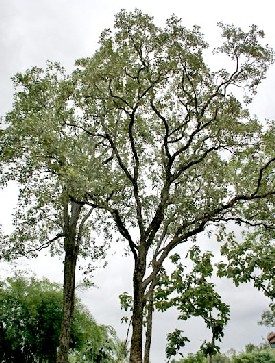
Photo: J. M. Garg - Red Sandalwood Tree
Rx. Resin puriss. [pure resin] {2.5 pounds} Terebinth [turpentine] {10 drams} pulv. rad Consolid maj. [powdered comfrey] {4 ounces} Barb Caprin. [goat's beard] {3 drams} Bol Armen ppt. [Armenian Bole - an earthy, often red, clay] {2.5 ounces} Tutiæ ppt. [Tutty - zinc oxide - precipitate] {1.5 drams} Lap. Osteocoll. [carbonate of lime] {3.5 drams} Sandal. Rubr. [Santalum rubrum - red sandalwood] {3 ounces} Succin. [amber] Mumiæ [ground up mummy] ana {1 dram} Terr. Sigillat [Terra sigillata - reddish-brown clay] {10 drams} Mice fiat Emplastr secundum Artem [mix into a plaster, according to art]6
John Woodall also provides a recipe for a fracture-healing plaster. His includes: "Rx Bole [clay] {3 ounces}, Aluminis. [alum], Thus [Frankencense], ana. [mixed] {half ounce, Radix Consolida [comfrey roots] in powder {2 drams} [and] Lepis Abulosus [a German patent medicine also called Lapis Zabulousus] { half ounce}. This all made into fine powder, and mixed with the yolkes and whites of two egges together, if they may bee had, adding wine vineger, and mixed as much as will serve to make this medicine into the forme of a cataplasme [plaster]"7. Wanting that, Woodall notes that he has "done very well many times, onely with Allum, Bole, Egges, water and vineger, though Beane flower is also very good or wheat flower"8.
2 See John Moyle, The Sea Chirurgeon, p. 16-7; 2 Richard Wiseman, Of Wounds, Severall Chirurgicall Treatises, p. 426; 3 Wiseman, p. 426; 4 John Atkins, The Navy Surgeon, p. 47; 5 Moyle, p. 121; 6 Matthias Gottfried Purmann, Churgia Curiosa, p. 213-4; 7 John Woodall, the surgions mate, p. 162-3; 8 Woodall,p. 163
Inflammation Plaster
Richard Wiseman also suggests a plaster for treating fractures with inflamed or infected wounds. He notes that in this case the surgeon must use things that "dry up Serosities [serums or fluids], and repel Inflammation."1
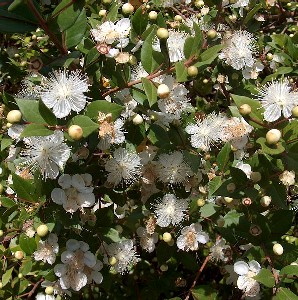
Photo: Giancarlo Dessì - Myrtle Flowers
If the Inflammation be not great, I then take empl. diapalmæ [diapalma plaster - see the section on plasters] and some of the forementioned Powders [in the section on topical medicines], with a little Oil of Myrtil and Vinegar, made up to the consistence of an Emplaster, which I spread upon Cloth pretty thick, and apply over the Fracture. It not only restrains the Defluxion [flow humors in the part], but strengthens the Fracture. The Medicaments proposed are all very good, and excellently preserve the Tone of the Part, if they be proportioned according to the greatness of the Malady.2
1 Richard Wiseman, Of Wounds, Severall Chirurgicall Treatises, p. 469; 2 Wiseman, p. 469-70
Clysters
Where there are ill humors, there is usually purging. Where there is purging, there are often enemas (clysters). Yet clysters have only limited support in curing fractures from our authors.
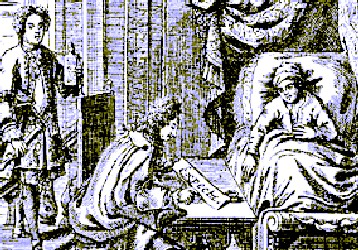
Bringing the Enema Syringe, From Ars sanandi cum
expectalione, by Georg Ernst Stahl (1730)
Woodall, ever ready to purge the sailor, suggests "if need so require, a lenitive [laxative] glister [clyster - enema] may bee given"1. Woodall goes into greater detail on the matter, explaining that the healing patient should "have the benefit of nature, that is onely every day, or the second day, a naturall stoole or an artificiall helpe by suppositories or glisters."2 His desire here is to flush the bad humors out of the system.
Richard Wiseman also suggests the use of clysters, almost in a throwaway manner, in his explanation of excrementious humors forming around the healing bone. He advises his readers to keep the patient's "Belly soluble by Clysters, or otherwise"3, apparently referring to regularity in the same way Woodall does.
1 John Woodall, the surgions mate, p. 166; 2 Woodall,p. 162; 3 Richard Wiseman, Of Wounds, Severall Chirurgicall Treatises, p. 469
Topical Medicines
Some of the period surgeons recommended topical medicines to be applied directly to the fractured part. While we've already looked at defensive medicines that were applied to the first layer of bandages that were designed to defend the part from bad humors, there are some others suggested.
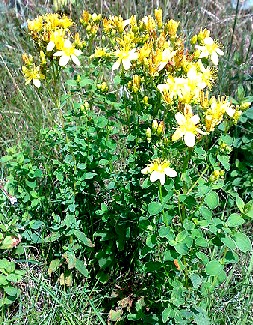
Photo: Wiki User Bjoertvedt
Hypericum Perforatum - St. John's Wort
John Woodall suggests a variety of 'commendable' topical medicines. First amongst these "is a good strong Lixivium [alkaline salts extracted from wood ashes] made with fresh water & ashes till it be slippery, namely, let the water be made seething hot ere the ashes be put in, adding if they be ready, or may be had in the shippe these hearbes following: St. Johns wort, wormewood, centaury, rosemary, sage, chamomile & mellilote flowers"1. Woodall explains that lixivium 'is the best healer'. If you don't have this, "the next best is the minerall of sea-salt". To apply, "wet the clowt [lint cloth] rehearsed therein, and wring it out hard, and apply it to smoothe, close and hot about the member binding it so up"2.
Richard Wiseman also discusses a topical treatment, although his focus is a different; he chooses astringent [tissues contracting] medicine. Wiseman uses egg whites combined with "Oil of Myrtil [oil of myrtle-berries], balaust. ros. rubr. [pomegranate and rose water] sang dracon. [Sanguis Draconis - resin secreted by Calamus Draco fruit] bol Armen. [bole armeniac] and with a little Wine made it up to the consistence of a Liniment, and applied it upon Cloaths over the Fracture."3 Wiseman reveals that using this treatment, he "cured a man whose Arm was sore bruised, and fractured in many pieces, by the fall of a piece of Cannon, which brake loose in a Storm, while we were preparing to lay aboard our enemy."4
1,2 John Woodall, the surgions mate, p. 163; 3,4 Richard Wiseman, Of Wounds, Severall Chirurgicall Treatises, p. 469
Medicines and Humors
There one other comment on medicine used during fracture treatment that is worth repeating. This is from Richard Wiseman, who while giving advice on how to 'restrain Defluxion' (fluids coming from the wound) advises the surgeon to do so "either by leneient [soothing and softening] Medicines, or by Deligation [bandaging]. We lenifie with soft cooling Oils."1
Cooling here refers to humor theory. Medicines (and everything, really) were thought to have four humoral properties - hot, cold, wet and dry. The prevailing idea in medicine at this time suggested that medicines that were opposite in nature to the illness they were used on should be applied. So his call to use cooling oils suggests that the fluids in the fracture have hot properties.
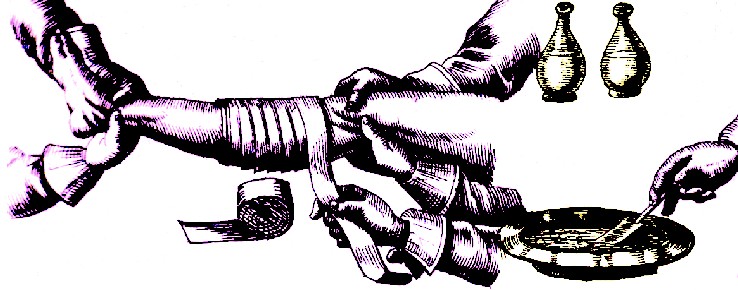 Bandaging & Using Oils to Repel Humors, From Armamentarium
Chirurgicum Bipartitum, Bandaging & Using Oils to Repel Humors, From Armamentarium
Chirurgicum Bipartitum, by Johannes Scultetus, p. 51 (1666) |
1 Richard Wiseman, Of Wounds, Severall Chirurgicall Treatises, p. 467

